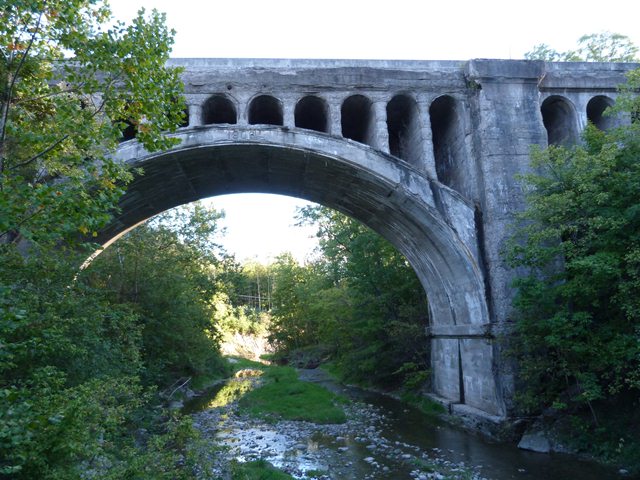We Recommend:
Bach Steel - Experts at historic truss bridge restoration.
BridgeHunter.com Phase 1 is released to the public! - Visit Now
Twin Railroad Bridge

Primary Photographer(s): Nathan Holth and Rick McOmber
Bridge Documented: September 23, 2012
Railroad (CSX, Former Big Four Railroad) Over West Fork White Lick Creek and Twin Bridges Road
Rural: Hendricks County, Indiana: United States
1906 By Builder/Contractor: Bates and Rogers of Chicago, Illinois
Not Available or Not Applicable
90.0 Feet (27.4 Meters)
275.0 Feet (83.8 Meters)
Not Available
3 Main Span(s)
Not Applicable

View Information About HSR Ratings
Bridge Documentation
View National Register of Historic Places Nomination Form For This Bridge
This bridge is oddly called Twin Railroad Bridge apparently because it is next to another bridge, a highway bridge. However, the railroad bridge is about as far from a twin as you can get. This is a massive, high level concrete railroad deck arch bridge, quite different from the low level, lightweight metal truss highway bridge. This highway truss actually sits in the footprint of the previous railroad bridge, a metal truss whose stone abutment remains nearby.
This bridge is one of two concrete arch bridges along this stretch of railroad line. The bridge has spalled severely, which has diminished its architectural details. It likely remains structurally intact however due to how heavily overbuilt these bridges were. With a 1906 construction date, this bridge is an early surviving example of a concrete arch bridge.
Information and Findings From DHPA Historic Bridge SurveyStatement of Significance Only a handful of open-spandrel railroad bridges survive, and they are by far the oldest in the state. This is one of three on the New York Central's tracks. In addition to its venerable age and monumental character, it is noteworthy for the coping of its rings. Architectural Description Where the distance between the roadway and the stream and the volume of the water carried by the watercourse are both considerable, the weight of the fill and the required side-to-side width of the structure
reduces the economic advantages of reinforced concrete arches under fill. The open-spandrel arch, which requires a good bit of formwork is therefore an expensive alternative, may then become the form of choice. In large
open-spandrel structures, the arch ring is often composed of two or more longitudinal ribs. A series of columns support the deck and transfer the loads to the ribs or ring. Beams and slabs, in turn, carry the floor below the
roadbed. Because of their expense, only a few such rail structures have been built in Indiana. Most resulted from the New York Central's double-tracking and grade separation programs early in the century. Bridge Considered Historic By Survey: Yes |
![]()
Photo Galleries and Videos: Twin Railroad Bridge
Bridge Photo-Documentation
Original / Full Size PhotosA collection of overview and detail photos. This gallery offers photos in the highest available resolution and file size in a touch-friendly popup viewer.
Alternatively, Browse Without Using Viewer
![]()
Bridge Photo-Documentation
Mobile Optimized PhotosA collection of overview and detail photos. This gallery features data-friendly, fast-loading photos in a touch-friendly popup viewer.
Alternatively, Browse Without Using Viewer
![]()
Maps and Links: Twin Railroad Bridge
Coordinates (Latitude, Longitude):
Search For Additional Bridge Listings:
Bridgehunter.com: View listed bridges within 0.5 miles (0.8 kilometers) of this bridge.
Bridgehunter.com: View listed bridges within 10 miles (16 kilometers) of this bridge.
Additional Maps:
Google Streetview (If Available)
GeoHack (Additional Links and Coordinates)
Apple Maps (Via DuckDuckGo Search)
Apple Maps (Apple devices only)
Android: Open Location In Your Map or GPS App
Flickr Gallery (Find Nearby Photos)
Wikimedia Commons (Find Nearby Photos)
Directions Via Sygic For Android
Directions Via Sygic For iOS and Android Dolphin Browser
USGS National Map (United States Only)
Historical USGS Topo Maps (United States Only)
Historic Aerials (United States Only)
CalTopo Maps (United States Only)

